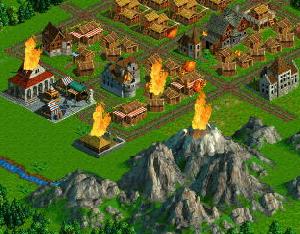Arrr, me mateys. Arrr.
It seems that there has been a “genre bender” trend in strategy gaming recently.
Mob Rule, a combination of RTS and simulation, couldn’t
seem to decide on being either. On the other hand, Majesty,
an RTS with some sim elements, turned out to be a great and well thought out
game.
1602 A.D. is the inverse of Majesty, a sim game featuring some
RTS elements. But while combination works pretty well, the actual battles are
awfully tame by today’s standards, and feel out of place with the rest of the
game.
Like many sim games, there isn’t much of a storyline. You’re the leader of a small group of pioneers who are trying to eke out a living in the New World. You have to settle on an island, give the people what they want, and try to make their lives as comfortable as possible.
I’ll get this out of the way right now: This game can be confusing. Really confusing. First off, the tutorials are nearly no help at all, giving you just three minutes of cursory information. That’s hardly enough to keep your head above water (or your enemies’ below water, for that matter). It took me at least four tries to create this world before I finally got the hang of it.
The real time system used to simulate the world is actually pretty interesting. You lay out roads, build houses, and then build businesses. These aren’t contemporary businesses, mind you. They have to get material from somewhere, and need somewhere else to send it. Each business can only “reach” a certain distance to get raw materials for their products. In order to keep everything running smoothly, you have to keep all the businesses in close proximity, as well as make sure they are working at full efficiency. As you build more things, your population will grow and ask for more stuff, which will then in turn require you to build more things (Isn’t that a George Carlin joke? – Ed.)
Add to that diplomacy between different nations, buying and selling goods
on the free market, and trading goods around the whole map, and you have a satisfying
simulation.
However, it is in the battle system where the game goes sour. You’re very
limited in your choices of fighting units, with only four available. Add to
this only two types of ships, and the grand total is a paltry six battle
units!
 The battles
The battles
amount to a bunch of guys standing still, firing at each other as their health
bars go down. Boring. It’s infinitely more interesting to try to wheel and deal
with your opponents, rather than try to beat the crap out of them.
The worst thing about the game is the interface, which consists of a bar on
the side of the screen that contains all the buttons you need to play. As you
go from building to building, the buttons change around on this panel. But unlike
games like Civilization, which has a pretty obvious interface, buttons
in 1602 A.D. don’t show up in logical places, nor do they always look
like buttons. This is particularly noticeable when you’re setting up automatic
trade routes with other countries. Selecting whether to load or unload a particular
resource is also confusing, since it’s not really clear if a left facing arrow
means to load a resource, or if it means to unload it.
After you’ve learned the interface, you can use it without too much of a problem. Again, it’s just the learning process that is a pain.
The game’s presentation is reasonable. Although in 2D, the graphics are quite
well done, with a distinct 17th Century flair that fits in nicely with the subject
matter. Your townspeople and buildings are animated smoothly and are drawn well.
Sounds from butcher shops, grain fields, and blacksmiths add nicely to the atmosphere,
while selections like Pachelbel’s canon in D finish it off.
Although plenty of thought went into the internal workings of 1602 A.D.,
the interface, combat and tutorials are left somewhat unfinished. If you have
the time and patience to learn the game, you’ll probably have fun. Otherwise,
full to starboard out of here.

-
Interesting game system
-
Good graphics and sound
-
Tough to learn
-
Bad interface
-
Lame battles







